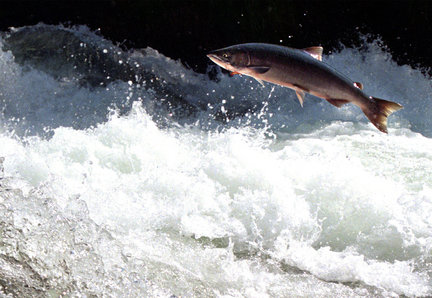forum
library
tutorial
contact

Columbia River Sockeye Return Best Since 1923
by StaffColumbia Basin Bulletin, July 13, 2012
|
the film forum library tutorial contact |

|
Columbia River Sockeye Return Best Since 1923by StaffColumbia Basin Bulletin, July 13, 2012 |
Snake River Sockeye Fall Short Of Preseason Estimate
 The 2012 sockeye salmon return to the Columbia River is far and away the best dating back to 1923, though the Snake River component of that run is not as strong as expected.
The 2012 sockeye salmon return to the Columbia River is far and away the best dating back to 1923, though the Snake River component of that run is not as strong as expected.
Through Thursday a total of 507,951 sockeye had been counted passing up and over the lower Columbia's Bonneville Dam. The dam count alone easily surpasses the modern-day total (back to 1938 when dam counts began) for an annual sockeye return to the mouth of the Columbia River. The previous high was 387,858 sockeye to the mouth of the river in 2010. Bonneville is at river mile 146.
The record count does not include about 5,000 sockeye caught in the lower river this year by anglers and commercial fishers.
The Washington Department of Fish and Wildlife' Joe Hymer says that estimations produced largely on the sockeye commercial catch indicate that as many as 700,000 sockeye may have entered the river in 1923.
The 2012 run is still proceeding. A total of 3,675 sockeye were counted at Bonneville on Thursday. The run is, however, well past its peak with counts now decreasing daily since a high count of more than 41,000 on June 26. That peak count was also a record.
The vast majority of the sockeye are on their way to the Okanogan and Wenatchee river basins, with less than 10 percent of that total estimated for the Wenatchee. The bulk of the run is bound for the Okanogan's Lake Osoyoos at the Washington-British Columbia borders. Fisheries officials estimate that about 90 percent of the Okanogan stock is of natural origin.
The preseason forecast was a return of 1,900 Snake River sockeye salmon to the mouth of the Columbia River. The Snake River stock is listed as endangered under the Endangered Species Act; the Wenatchee and Okanogan stocks are not listed.
The Snake River stock was listed in 1991 at a point when spawner returns had dwindled in a few years literally to zero. The Snake River sockeye have been preserved from extinction by a captive broodstock program launched during the same year as the listing. It spawned the few available wild fish to grow juvenile fish, and adults, in hatcheries in an attempt to boost the population.
The program has blossomed over the past four years with returns, as measured by dam counts at the lower Snake River's Lower Granite Dam, ranging from 909 (2008) to 2,201 in 2010. The count last year was 1,502. The sockeye swim about 900 river miles up the Columbia, Snake and Salmon rivers to reach their destination in central Idaho. Once they reach Lower Granite, the eighth dam they pass, they have 400 miles yet to swim.
With a preseason forecast of 1,900 at the mouth of the Columbia, fishery officials were expected over a thousand to reach Lower Granite. But through Wednesday only 147 had reached the lower Snake Dam, as compared to 188 through that date last year and 1,100 in 2010.
"We're not expecting the preseason forecast to be met," said Paul Kline, the Idaho Department of Fish and Game's Columbia River policy coordinator and former longtime head of the captive broodstock progam.
He said an estimated 503 Snake River sockeye had passed Bonneville through July 10, well below 2011's estimated total of 1,300 through that date. Based on recent year's runs, typically 70 to 90 percent of the Snake River run will have passed Bonneville by that date.
"That's still a hell of a lot of sockeye," Kline said, when compared to the 1990s when annual counts at Lower Granite only once got as high 15.
The Snake River sockeye run "is looking like it's going to come in about 50 percent of the preseason forecast," the IDFG's Alan Byrne told the Columbia River Compact Tuesday. "For whatever reason, the Snake River run did not perform as well" as the upper Columbia run this year. The Compact, made up of Oregon and Washington officials, sets Columbia mainstem commercial fishing seasons. Both sport and commercial fisheries are managed to minimize impacts on listed fish.
The start of construction on a new sockeye hatchery in Idaho was to be celebrated today by federal, state and tribal officials and others. The new facility is expected to raise sockeye smolt production to as high as 1 million per year, which in turn is expected to increase adult returns. Ultimately it is hoped that returning fish, many of which are allowed to spawn in the wild, will lift populations to self-sustaining levels. Roughly 10 percent of the returns in recent years have been of natural origin, most likely the produce of hatchery produce fish that were allowed to spawn in the Stanley Basin's Redfish Lake.
learn more on topics covered in the film
see the video
read the script
learn the songs
discussion forum
